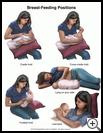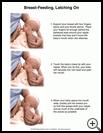
Breast-Feeding Positions
How should I hold my baby when feeding?
There are 4 main breast-feeding positions: the cradle hold, the cross-cradle hold, the football hold, and lying down.
- Cradle hold
The most common position is the cradle hold. This is when you are sitting with your baby in your lap and the baby's head is resting in the bend of your elbow on the same side where you will breast-feed. The baby's chest should be against your chest so that he doesn't have to turn his head to reach your nipple. Be sure the arm of the chair is at the right height to support your arm. Use pillows to support your back, your arm, and the baby's head. A footstool is also very helpful to raise your feet.
- Cross-cradle hold
The cross-cradle hold is similar to the cradle hold except your baby is supported on the arm and hand opposite the breast you are using. The baby's head rests between your thumb and fingers and his upper back is in the palm of your hand. This is a good position when first learning to breast-feed because it gives you more control of the baby's head while you are helping your baby take the breast in his mouth. It also is a good position for small babies and babies having trouble learning to latch correctly.
- Clutch hold (Football hold)
Hold your baby like a football along your forearm, with the baby's body on your arm, his feet pointing toward your back, and his face toward your breast. Use your other hand to support your breast. The football hold helps if you have engorged breasts or sore nipples. It is also a good position if you have had a cesarean section and cannot lay the baby on your stomach. If you often have plugged milk ducts, the football hold can help your baby drain the ducts at the bottom of the breast. It is also a good position for nursing twins!
- Lying down
Breast-feeding when you are lying down is good for night feeding. Lie on your side and place the baby on his side facing you, with his head near your breast and his mouth lined up with your nipple. You may want to place a couple of pillows at your back for some extra support. Be sure that the baby can breathe through his nose.
This position is restful for you. By changing your position slightly you can feed the baby from both breasts while lying on one side. It is also a good position if you have had a cesarean section and cannot lay the baby on your stomach.
- Laid-back nursing
For this position, lie back and place your baby’s tummy on your tummy. Gravity keeps your baby’s body securely against yours. This position may also help your baby to latch on properly and suck deeply with less effort.
After feeding, return the baby to his or her crib. Be sure to place your baby on his back for sleep. Avoid soft sleep surfaces, loose bedding, and situations in which your baby can fall, get too close to a heating appliance, or get trapped between your bed and a wall, headboard, or other furniture.
How do I get my baby to latch on to my breast?
In the first few days, place your baby skin-to-skin on your chest. The baby will bounce his head and step with his legs to move himself toward the breast. Once he is at the nipple, he will latch onto the breast and start nursing. Babies will often nurse 10 to 12 times in 24 hours when they are allowed to self-latch.
It is very important to get your baby to latch on correctly to your breast. If the baby is not latched on correctly, you will get sore nipples and the baby won't get as much milk.
To get a good latch:
- Hold your baby in one of the first 4 positions described above. With your other hand, support your breast with your fingers underneath your breast and your thumb on top (C-hold) or rotate your hand into a U-hold with your fingers and thumb on either side of the breast. Flatten your breast between your thumb and fingers (like a sandwich) to make it easier for your baby to take into his mouth.
- Turn your baby's whole body so he is facing your breast. Lightly touch the baby's upper lip with your nipple. His natural "rooting reflex" will make him open his mouth. You may need to touch his lip several times until he opens WIDE like a yawn.
- When he opens his mouth wide, move your baby's body and head together to bring your baby onto your breast. Aim your baby's lower lip as far from the base of the nipple as possible. Bring your baby's chin and lower jaw to the breast first. You want your baby's tongue to draw in as much breast as possible. Make sure the baby has a good hold on the nipple as well as the underside of the areola. NEVER allow the baby to suck on just the nipple. This will feel uncomfortable for you, and your baby will not get enough milk unless he takes a large amount of breast into his mouth. Continue to support your breast while your baby nurses, so that the nipple and areola don't get pulled out of your baby's mouth by the weight of the breast.
- Make sure your baby's nose is not pressed into the breast so that she can't breathe. If your breast is blocking the baby's nose, pull your baby's lower body closer to you and her nose should move away from the breast. Her chin should be pressed against your breast.
- If your baby does not latch on well, remove the baby from your breast by sliding your finger into your baby's mouth and pressing down on the breast. This will break the suction. Then try again.
Tips on Breast-feeding Positions
- As a general rule, anything that works is OK as long as the baby has both the nipple and much of the areola in his mouth and he can breathe.
- Change the nursing position sometimes to make sure all of the milk ducts are drained of milk.
- Always find a relaxed and comfortable position.
Special Situations
Nursing After Having a Cesarean Section
- The lying-down position may be more comfortable for breast-feeding after you have had a cesarean section. The hospital nurses will help you change from side to side.
- If you nurse sitting down, put a pillow on your lap to protect the incision.
- The football hold can also be used, since it keeps the baby from pressing on your incision.
Nursing Premature Infants
- The football and cross-cradle holds work best for premature babies.
- Support the baby’s head and neck in the cross-cradle or football hold with his body supported by your forearm. Use your other hand to support your breast and “sandwich” your breast between your thumb and fingers. Lightly touch his upper lip with your nipple. When he opens his mouth wide, bring him onto your breast.
- If the baby's nursing reflex is weak, you can increase milk flow by briefly squeezing your breast between your thumb and fingers. You do not need to squeeze constantly. Just squeeze, release, squeeze again and release again. Your baby may start sucking again when the squeezing gives him extra milk.
Nursing Twins
- Use the football hold with pillows under each arm to support the babies. Using pillows helps free up your hands.
- You can use the cradle or cross-cradle hold and have the babies legs overlap.
- You can combine holds (for example, use the cradle hold for one baby and the football hold for the other).
- Alternate between feeding each baby separately and nursing the babies at the same time.
- Don't let one baby feed from just one breast. Make sure each baby feeds from each breast. This will help keep a good milk supply in both breasts.
- If you can tell that one of your babies is hungrier than the other, nurse the hungriest baby on the fullest breast.
Last modified: 2011-11-28
Last reviewed: 2011-11-28


